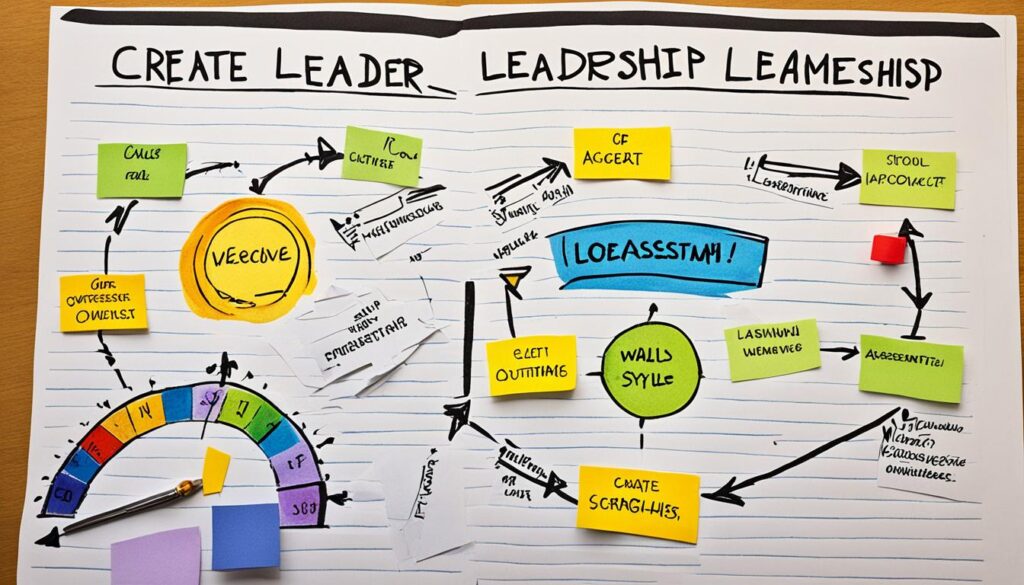Navigating Leadership Styles for Success

As a leader, have you ever wondered how your leadership style can impact your team’s success? Do you believe there is one “right” leadership style that guarantees effectiveness? Let’s explore the fascinating world of leadership styles and discover how different approaches can influence the workplace and drive organizational success.
Key Takeaways:
- Understanding different leadership styles is crucial for successful leadership.
- There is no universally “right” leadership style; it varies based on the organizational context.
- Different leadership styles have different impacts on employee engagement and performance.
- Assessing your own leadership style can help you identify your strengths and areas for improvement.
- Effective communication, continuous learning, trust-building, and empathy are key elements of effective leadership.
The Importance of Leadership Styles
Leadership styles play a significant role in shaping the work environment and influencing employee engagement and performance. A leader’s choice of leadership style can greatly impact the success of their team and organization. Different leadership styles have their own strengths and weaknesses, and effective leaders must carefully assess which style is most appropriate for their specific organizational context.
By understanding the different types of leadership styles and their effects, leaders can make informed decisions that inspire and motivate their teams to reach their full potential. An effective leadership style provides guidance, fosters collaboration, and encourages creativity within the workplace. It sets the tone for the team’s dynamics, communication, and overall productivity.
Effective leadership styles are not one-size-fits-all; rather, they are tailored to fit the unique needs and goals of the organization and its members.
Some leaders may find that an autocratic leadership style, which involves making decisions unilaterally, works well in certain situations where quick decision-making is crucial. On the other hand, a democratic leadership style, which involves involving team members in the decision-making process, can foster a sense of ownership and collaboration among team members.
Transformational leadership style, which focuses on inspiring and motivating employees towards achieving a shared vision, can be highly effective in driving innovation and growth within the workplace. Meanwhile, a situational leadership style requires leaders to adapt their approach based on the specific needs of the team and the situation at hand.
By selecting the most suitable leadership style and adapting it as needed, leaders can create a work environment that empowers and engages their team members. They can build trust, encourage open communication, and develop a culture of continuous growth and improvement.
Key Points:
- Leadership styles significantly influence the work environment and employee performance.
- Effective leadership styles are tailored to the specific needs and goals of the organization.
- Leaders must assess different leadership styles to choose the most suitable one for their context.
- An effective leadership style inspires and motivates employees to achieve high levels of success.
- Autocratic, democratic, transformational, and situational leadership styles each have their own benefits and limitations.
By understanding the importance of leadership styles and selecting the most appropriate one, leaders can create a positive and productive work environment that drives success and facilitates the growth and development of their team.
Understanding Different Leadership Styles
Leadership styles vary widely, with each style possessing its unique characteristics and approaches. To effectively navigate the complexities of leadership, it is essential for leaders to comprehend the different leadership styles and their respective benefits and implications. By adopting the appropriate leadership style, leaders can maximize their team’s potential and drive organizational success.
Autocratic Leadership Style
The autocratic leadership style is characterized by leaders making decisions unilaterally, without significant input from team members. In this style, leaders possess full control and authority over decision-making processes, with little room for collaborative input from their teams. While autocratic leadership can be effective in specific situations that require quick and decisive actions, it may hinder team members’ engagement and creativity due to the lack of involvement.
Democratic Leadership Style
The democratic leadership style, on the other hand, emphasizes inclusivity and shared decision-making. Leaders with a democratic leadership style actively involve team members in the decision-making process, seeking their input and considering their perspectives. This approach fosters a sense of ownership and empowerment among team members, leading to increased engagement and innovative problem-solving.
Transformational Leadership Style
The transformational leadership style focuses on inspiring and motivating employees to achieve exceptional performance. Transformational leaders set a compelling vision, inspire their teams to embrace change, and provide individualized support to help team members reach their full potential. By employing this style, leaders can cultivate a culture of growth, collaboration, and continuous improvement within their organizations.
Situational Leadership Style
The situational leadership style emphasizes adaptability and flexibility. Leaders who adopt this style adjust their leadership approach based on the specific needs of their team and the situation at hand. They recognize that different circumstances require different leadership strategies, and they are skilled at tailoring their behaviors to provide the necessary support and guidance to their team members.
“Great leaders are not defined by a single leadership style, but by their ability to adapt and apply the most appropriate leadership style based on the situation and the needs of their team.”
Each leadership style has its own strengths and weaknesses, and there is no one-size-fits-all approach. Leaders must evaluate the context, goals, and team dynamics to determine which leadership style will be most effective. By understanding the diverse range of leadership styles and their application, leaders can build strong, engaged teams and drive organizational success.
The Impact of Leadership Styles in the Workplace
The choice of leadership style has a significant impact on the workplace. Different leadership styles can shape the overall work environment and ultimately influence the success of an organization. Let’s explore how different leadership styles affect the workplace:
1. Autocratic Leadership Style
The autocratic leadership style is characterized by leaders having full control and making decisions without soliciting input from their team members. While this style can promote efficiency and quick decision-making, it can also lead to a lack of employee engagement and creativity. When employees are not involved in the decision-making process, their motivation and job satisfaction may decrease, which can ultimately impact their productivity and overall performance.
2. Democratic Leadership Style
The democratic leadership style emphasizes collaboration and inclusivity. Leaders who adopt this style actively involve their team members in the decision-making process, seeking their input and feedback. This promotes a sense of ownership and fosters a collaborative work environment where everyone’s opinions are valued. In turn, this can boost employee engagement, creativity, and overall job satisfaction.
3. Transformational Leadership Style
The transformational leadership style focuses on inspiring and motivating employees to achieve their full potential. Transformational leaders exhibit charisma, vision, and a genuine concern for the development and growth of their team members. By setting high expectations, providing support, and empowering their employees, transformational leaders stimulate innovation, creativity, and continuous improvement throughout the organization.
4. Situational Leadership Style
The situational leadership style requires leaders to adapt their approach based on the specific needs of their team and the situation at hand. This style recognizes that different circumstances may call for different leadership behaviors. Situational leaders excel in assessing the skills and capabilities of their team members and adjusting their leadership style accordingly. This flexibility allows them to effectively guide their team through various challenges and achieve optimal results.
Understanding the impact of leadership styles in the workplace is crucial for leaders who are striving to create a positive and productive work environment. By selecting the most appropriate leadership style for their team and organizational context, leaders can maximize employee engagement, creativity, and performance.
Key Takeaways
- Autocratic leadership style may result in low employee engagement and limited creativity.
- Democratic leadership style promotes collaboration, inclusivity, and higher job satisfaction.
- Transformational leadership style inspires innovation, growth, and continuous improvement.
- Situational leadership style allows leaders to adapt their approach based on the needs of the team and situation.
Next, we will explore how leaders can assess their own leadership style and make adjustments to enhance their effectiveness.
Assessing Your Leadership Style
Understanding your leadership style is crucial for personal growth and effective leadership. By assessing your own leadership style, you can gain valuable insights into your strengths and weaknesses, allowing you to make informed decisions and improve your leadership skills. There are various assessments and quizzes available that can help you evaluate your leadership style and identify areas for development.
One popular leadership style assessment is the Leadership Style Quiz, which presents a series of scenarios and asks you to choose the response that best aligns with your leadership approach. This quiz helps you identify your dominant leadership style and provides a holistic view of your leadership strengths and weaknesses. By taking the quiz, you can gain a clearer understanding of your leadership tendencies and areas where you can further enhance your skills.
Leadership style assessments provide valuable insights into how you lead and interact with your team. By gaining clarity on your leadership style, you can make adjustments to better align your approach with your team’s needs and goals.
Another popular assessment tool is the Leadership Style Inventory, which measures the degree of eight leadership styles you possess, including autocratic, democratic, transformational, and situational styles. This assessment helps you understand the balance between different leadership styles that you exhibit and highlights areas where you can further develop your leadership abilities.
By engaging in these assessments, you can gain self-awareness and become more intentional in your leadership approach. Armed with this knowledge, you can adapt your leadership style to different situations and individuals, fostering a more productive and positive work environment.
Remember, assessing your leadership style is just the first step. It’s essential to reflect on the results and actively work on enhancing your leadership skills. Seek feedback from your team and colleagues, attend leadership development programs, and continuously update your knowledge to refine your leadership style and achieve greater success.
Benefits of Leadership Style Assessment:
- Gains insights into strengths and weaknesses
- Identifies areas for improvement
- Helps align leadership approach with team needs
- Enhances self-awareness and personal growth
- Enables adaptation to different situations
Leadership style assessment provides valuable information that can guide your leadership journey. By understanding your leadership style and continuously working towards improvement, you can become a more effective and influential leader.

The Importance of Effective Communication in Leadership
Effective communication is a fundamental pillar of successful leadership. Leaders who possess effective communication skills are better able to guide their teams, inspire collaboration, and achieve organizational goals. By articulating their vision and objectives clearly and actively listening to their team members, leaders can foster an atmosphere of trust and open dialogue.
Research has shown that organizations with effective communication practices tend to have higher employee satisfaction, engagement, and productivity levels. As a leader, your ability to communicate effectively can significantly impact the overall success of your team and organization.
To cultivate a culture of effective communication, leaders must communicate openly and transparently with their team members. By being approachable and receptive to feedback, leaders encourage their team members to express their ideas and concerns freely. This, in turn, can foster creativity, problem-solving, and innovation within the team.
Active listening is also crucial for effective communication in leadership. When leaders actively listen to their team members, they demonstrate respect and empathy, making team members feel heard and valued. This not only builds stronger relationships but also allows leaders to gain valuable insights and perspectives that can inform their decision-making process.
Moreover, effective communication enables leaders to provide clear instructions, expectations, and feedback to their team members. By ensuring that everyone understands their roles and responsibilities, leaders can optimize team performance and avoid miscommunication or misunderstandings that may hinder progress.
To enhance their communication skills, leaders can participate in training programs, workshops, or seminars focused on leadership communication. These development opportunities can provide valuable insights and practical techniques for effective communication in various leadership scenarios.
The Power of Effective Communication in Leadership
According to a study conducted by Forbes Business Development Council, effective communication is directly linked to higher employee engagement, productivity, and overall organizational success. The study emphasizes the importance of leaders establishing clear communication channels, providing regular updates, and fostering a culture of open dialogue within their teams.
| Benefits of Effective Communication in Leadership | |
|---|---|
| Better team alignment and coordination | |
| Reduced conflicts and misunderstandings | |
| Increased trust and transparency | |
| Improved decision-making | |
| Enhanced employee engagement and motivation |
To summarize, effective communication is vital for effective leadership. By honing their communication skills, leaders can inspire and motivate their teams, promote collaboration and innovation, and create a positive and productive work environment.
Continuous Learning and Adaptability in Leadership
Continuous learning and adaptability are key traits of effective leaders. In today’s rapidly changing business landscape, leaders must stay ahead of the curve by continuously acquiring new knowledge and skills. By investing in personal and professional development, leaders can enhance their leadership capabilities and make informed decisions for their teams and organizations.
Continuous learning allows leaders to keep up with the latest trends and developments in their industry. It enables them to gain a deeper understanding of market dynamics, customer needs, and emerging technologies. By staying well-informed, leaders can adapt their strategies and approaches to meet the evolving demands of their business environment.
Adaptability is another crucial aspect of effective leadership. Leaders who are adaptable can navigate challenges and seize opportunities with agility. They can adjust their plans and pivot their strategies when unexpected circumstances arise. By embracing change and remaining flexible, leaders can steer their teams towards success even in uncertain times.
Continuous learning and adaptability go hand in hand, as leaders must continuously learn in order to adapt effectively. By actively seeking new knowledge and insights, leaders can develop innovative solutions to complex problems and inspire their teams to do the same.
“Adaptability is not imitation. It means power of resistance and assimilation.”
– Mahatma Gandhi
Leaders can foster a culture of continuous learning within their organizations by encouraging their team members to engage in professional development activities. This can include attending workshops, seminars, or conferences, pursuing further education, or participating in mentorship programs. By supporting their employees’ growth and development, leaders not only enhance their team’s skills but also create a sense of loyalty and commitment.
Benefits of Continuous Learning and Adaptability in Leadership
Continuous learning and adaptability offer a range of benefits for leaders and their organizations:
- Improved decision-making: By staying informed and continuously learning, leaders can make well-informed decisions based on the latest information and insights.
- Enhanced problem-solving: Continuous learning enables leaders to develop a broader perspective and think creatively when addressing complex problems.
- Increased innovation: Leaders who are adaptable and continuously learning are more likely to embrace innovation and drive positive change within their organizations.
- Increased employee engagement: By promoting a culture of continuous learning, leaders can foster a sense of growth and development among their team members, leading to higher levels of employee engagement and satisfaction.
- Improved organizational agility: Adaptable leaders can respond quickly to changing market conditions, allowing their organizations to stay ahead of the competition.
Effective leaders understand the value of continuous learning and adaptability and actively seek opportunities to expand their knowledge and skills. By embracing a mindset of continuous improvement, leaders can lead their teams to success in today’s dynamic and ever-changing business environment.
Building Trust and Empathy in Leadership
Building trust and empathy are crucial elements of effective leadership. As leaders, it is essential to establish trust with our teams through transparent, consistent, and authentic communication. By fostering an environment of trust, we create a solid foundation for collaboration and productivity.
One way to build trust is by actively listening to our team members’ needs and concerns. When we show empathy towards their challenges and experiences, we demonstrate our understanding and support. This helps to create a safe space where individuals feel valued and motivated to contribute their best work.
“Empathy is about standing in someone else’s shoes, feeling with his or her heart, seeing with his or her eyes. Not only is empathy hard to outsource and automate, but it makes the world a better place.” – Daniel H. Pink
Empathy in leadership is not only beneficial for individual well-being but also for team dynamics and overall performance. When leaders show empathy, they encourage open communication and foster a culture of collaboration. Team members feel comfortable sharing their ideas and concerns, leading to innovative solutions and increased motivation.
Additionally, empathy helps leaders understand the unique strengths and challenges of each team member. By recognizing their individual needs, we can provide the necessary support and resources to help them succeed. This personalized approach builds trust and strengthens the bond between leaders and their teams.
Research shows that leaders who prioritize empathy have higher employee engagement and retention rates. When employees feel understood and supported, they are more likely to be loyal and committed to their work. This, in turn, leads to higher productivity and organizational success.
The Importance of Trust and Empathy in Remote Leadership
In today’s remote work environment, trust and empathy are even more critical. Without the physical presence and face-to-face interactions, leaders must rely on effective communication and empathy to build strong relationships with their remote teams.
Leaders can foster trust by setting clear expectations, providing regular feedback, and being accessible to their remote team members. Creating a sense of psychological safety and demonstrating empathy towards the unique challenges of remote work helps to establish a supportive and inclusive virtual environment.
By leveraging technology, leaders can encourage collaboration and connection among remote team members. Virtual team-building activities, regular check-ins, and opportunities for social interaction can help create a sense of belonging and strengthen the bond within the team.
Ultimately, effective leadership requires a combination of trust, empathy, and strong communication skills. By prioritizing these qualities, leaders can inspire their teams, drive success, and create a positive work culture.
Conclusion
Effective leadership is a complex and dynamic process that requires understanding different leadership styles, assessing one’s own style, and continuously learning and adapting. By harnessing the power of effective leadership styles, leaders can navigate the challenges they face and create a successful work environment.
Building trust, effective communication, and empathy are crucial elements of effective leadership. By establishing trust, leaders can inspire their teams and foster a collaborative work environment. Effective communication ensures that the vision and objectives are clearly understood, while empathy allows leaders to create a supportive and inclusive workplace.
Leaders who embrace effective leadership styles have the ability to motivate and inspire their teams to achieve their full potential. By understanding the unique strengths and weaknesses of different leadership styles, leaders can tailor their approach to best meet the needs of their organization and their team members. As leaders continuously learn and adapt, they can stay ahead of the curve and make informed decisions that drive their teams and organizations towards success.






